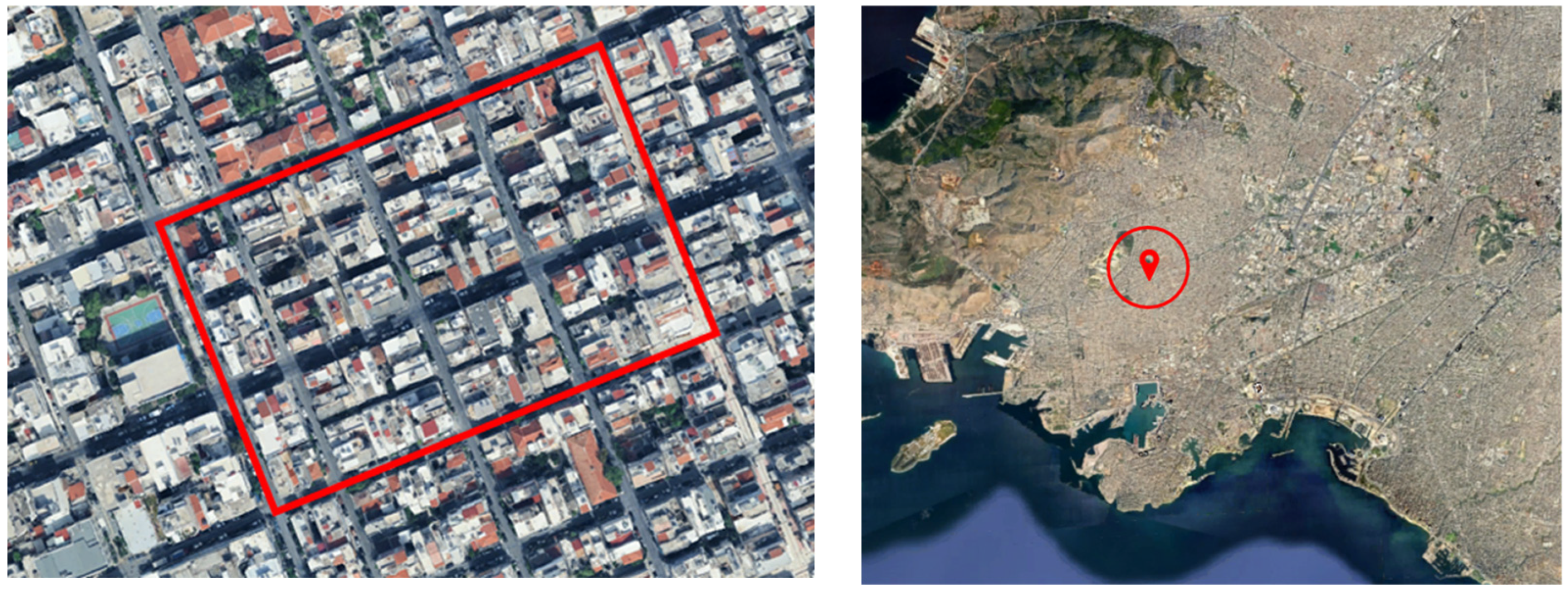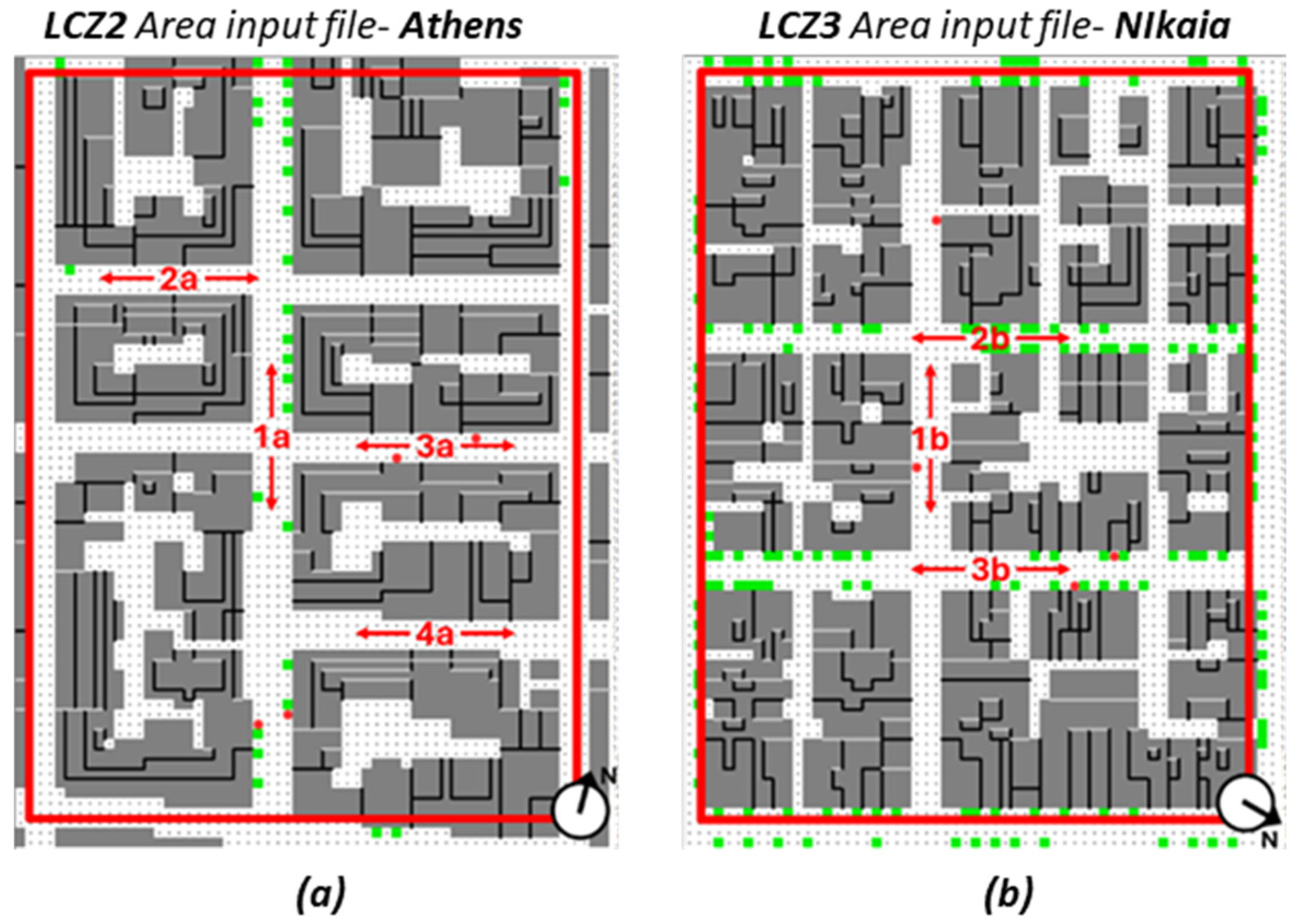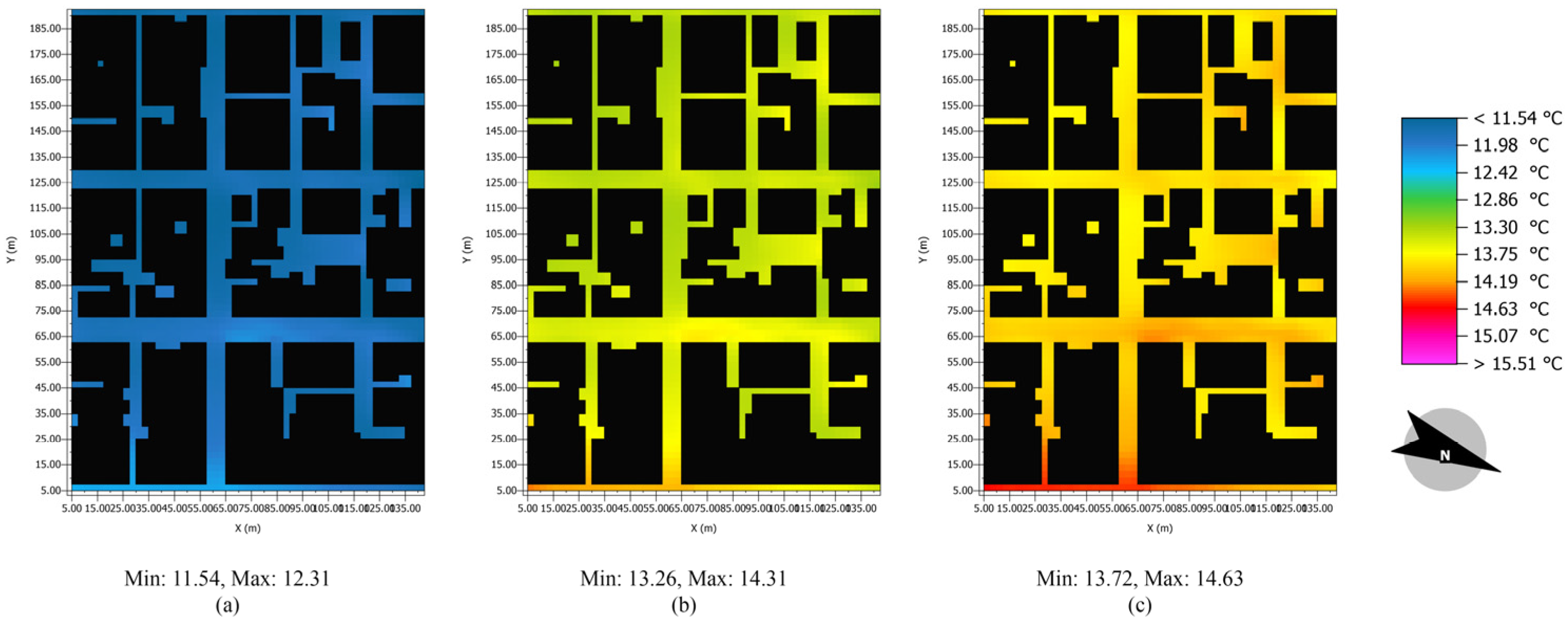Modeling Future Urban Microclimates in Athens, Greece: An ENVI-Met Analysis of Local Climate Zones Under Different Emission Scenarios
Abstract
1. Introduction
2. Materials and Methods
2.1. Selection of the Case Study Areas
2.2. Selection of the Simulation Days
2.3. Simulation Scenarios ENVI-Met Simulation Set-Up
3. Results and Discussion
3.1. Microclimatic Conditions in Case Study Area LCZ2-Athens
3.1.1. Analysis on Tair Values During the Typical Winter Day in January
3.1.2. Analysis of Tair Values During the Typical Summer Day in July
3.2. Microclimatic Conditions in Case Study Area LCZ3-Nikaia
3.2.1. Analysis on Tair Values During the Typical Winter Day in January
3.2.2. Analysis of Tair Values During the Typical Summer Day in July
4. Conclusions
Author Contributions
Funding
Data Availability Statement
Conflicts of Interest
References
- Clos, J. A New Urban Agenda for the 21st century: The role of urbanisation in sustainable development. OECD Reg. Outlook 2016, 239–249. [Google Scholar]
- Oke, T.R. Boundary Layer Climates; Routledge: London, UK, 2002. [Google Scholar]
- Rizwan, A.M.; Dennis, L.Y.C.; Liu, C. A review on the generation, determination and mitigation of Urban Heat Island. J. Environ. Sci. 2008, 20, 120–128. [Google Scholar] [CrossRef] [PubMed]
- Zhan, D.; Sezer, N.; Hou, D.; Wang, L.; Hassan, I.G. Integrating urban heat island impact into building energy assessment in a hot-arid city. Buildings 2023, 13, 1818. [Google Scholar] [CrossRef]
- Andrade, C.; Fonseca, A.; Santos, J.A. Climate change trends for the Urban Heat Island intensities in two major Portuguese cities. Sustainability 2023, 15, 3970. [Google Scholar] [CrossRef]
- Papamanolis, N. The main characteristics of the urban climate and the air quality in Greek cities. Urban. Clim. 2015, 12, 49–64. [Google Scholar] [CrossRef]
- Maloutas, T.; Arapoglou, V.; Kandylis, G.; Sayas, J. Social polarization and de-segregation in Athens. In Residential Segregation in Comparative Perspective; Routledge: London, UK, 2012; pp. 257–283. [Google Scholar]
- Tsirigoti, D.; Bikas, D. A cross scale analysis of the relationship between energy efficiency and urban morphology in the Greek city context. Procedia Environ. Sci. 2017, 38, 682–687. [Google Scholar] [CrossRef]
- Theodoridou, I.; Papadopoulos, A.M.; Hegger, M. A feasibility evaluation tool for sustainable cities–A case study for Greece. Energy Policy 2012, 44, 207–216. [Google Scholar] [CrossRef]
- Beriatos, E.; Gospodini, A. “Glocalising” urban landscapes: Athens and the 2004 Olympics. Cities 2004, 21, 187–202. [Google Scholar] [CrossRef]
- Toparlar, Y.; Blocken, B.; Maiheu, B.; van Heijst, G.J.F. A review on the CFD analysis of urban microclimate. Renew. Sustain. Energy Rev. 2017, 80, 1613–1640. [Google Scholar] [CrossRef]
- Tsoka, S.; Tsikaloudaki, A.; Theodosiou, T. Analyzing the ENVI-met microclimate model’s performance and assessing cool materials and urban vegetation applications–A review. Sustain. Cities Soc. 2018, 43, 55–76. [Google Scholar] [CrossRef]
- Jänicke, B. Review of Models and Tools for Climate-sensitive Urban Design. In Proceedings of the 10th International Conference on Urban Climate/14th Symposium on the Urban Environment, New York, NY, USA, 6–10 August 2018. [Google Scholar]
- Zou, J.; Lu, H.; Shu, C.; Ji, L.; Gaur, A.; Wang, L.L. Multiscale numerical assessment of urban overheating under climate projections: A review. Urban. Clim. 2023, 49, 101551. [Google Scholar] [CrossRef]
- Tsoka, S.; Velikou, K.; Tolika, K.; Tsikaloudaki, A. Evaluating the combined effect of climate change and urban microclimate on buildings’ heating and cooling energy demand in a mediterranean city. Energies 2021, 14, 5799. [Google Scholar] [CrossRef]
- Błażejczyk, K.; Baranowski, J.; Jendritzky, G.; Błażejczyk, A.; Bröde, P.; Fiala, D. Regional features of the bioclimate of Central and Southern Europe against the background of the Köppen-Geiger climate classification. Geogr. Pol. 2015, 88, 439–453. [Google Scholar] [CrossRef]
- Agathangelidis, I.; Cartalis, C.; Santamouris, M. Urban morphological controls on surface thermal dynamics: A comparative assessment of major European cities with a focus on Athens, Greece. Climate 2020, 8, 131. [Google Scholar] [CrossRef]
- Stewart, I.D.; Oke, T.R. Local climate zones and urban climatic mapping. In The Urban Climatic Map; Routledge: London, UK, 2015; pp. 449–453. [Google Scholar]
- Velikou, K.; Tolika, K.; Anagnostopoulou, C.; Zanis, P. Sensitivity analysis of RegCM4 model: Present time simulations over the Mediterranean. Theor. Appl. Climatol. 2019, 136, 1185–1208. [Google Scholar] [CrossRef]
- Zaraveli, Z.; Theodoridou, I.; Tsoka, S.; Velikou, K. Re.Nature Cities. Deliverable 1.1: Case Study Areas and Simulation Days; Zenodo: Geneva, Switzerland, 2024. [Google Scholar] [CrossRef]
- Elguindi, N.; Bi, X.; Giorgi, F.; Nagarajan, B.; Pal, J.; Solmon, F.; Giuliani, G. Regional Climate Model RegCM Reference Manual; Version 4.7; The Abdus Salam International Centre for Theoretical Physics (ICTP): Trieste, Italy, 2017; 49p. [Google Scholar]
- Grell, G.A.; Dudhia, J.; Stauffer, D.R. A Description of the Fifth-Generation Penn State/NCAR Mesoscale Model (MM5); NCAR Technical Note NCAR/TN-398+STR; National Center for Atmospheric Research: Boulder, CO, USA, 1994. [Google Scholar]
- Tsoka, S.; Tolika, K.; Theodosiou, T.; Tsikaloudaki, K.; Bikas, D. A method to account for the urban microclimate on the creation of ‘typical weather year’datasets for building energy simulation, using stochastically generated data. Energy Build. 2018, 165, 270–283. [Google Scholar] [CrossRef]
- Bruce, M.; Fleer, H. Simulating surface–plant–air interactions inside urban environments with a three dimensional numerical model. Environ. Model. Softw. 1998, 13, 373–384. [Google Scholar] [CrossRef]
- Rong, Y.; Song, J.; Xu, Z.; Lin, H.; Liu, J.; Yang, B.; Guo, S. Performance Evaluation and Simulation Optimization of Outdoor Environmental Space in Communities Based on Subjective Comfort: A Case Study of Minhe Community in Qian’an City. Buildings 2025, 15, 2078. [Google Scholar] [CrossRef]
- Liu, Y.; Bi, L.; Hu, R.; Ye, L.; Zheng, W.; Lan, Y. Microclimate of Outdoor Tree-Lined Boulevards in University Campuses in Hot Summer and Cold Winter Regions: A Case Study of a University in Guilin. Buildings 2025, 15, 1476. [Google Scholar] [CrossRef]
- Tsoka, S.; Pappa, V.; Markos, N.; Bouris, D. Assessing the effect of citrus plant on the improvement of the outdoor thermal environment using wind tunnel and ground-based Leaf Area Index measurements. In Proceedings of the EGU General Assembly Conference Abstracts, Vienna, Austria, 14–19 April 2024; p. 20879. [Google Scholar]
- Krüger, E.; Minella, F.; Matzarakis, A. Comparison of different methods of estimating the mean radiant temperature in outdoor thermal comfort studies. Int. J. Biometeorol. 2014, 58, 1727–1737. [Google Scholar] [CrossRef]
- Faragallah, R.N.; Ragheb, R.A. Evaluation of thermal comfort and urban heat island through cool paving materials using ENVI-Met. Ain Shams Eng. J. 2022, 13, 101609. [Google Scholar] [CrossRef]
- Zittis, G.; Hadjinicolaou, P.; Klangidou, M.; Proestos, Y.; Lelieveld, J. A multi-model, multi-scenario, and multi-domain analysis of regional climate projections for the Mediterranean. Reg. Environ. Change 2019, 19, 2621–2635. [Google Scholar] [CrossRef]
- Founda, D.; Giannakopoulos, C. The exceptionally hot summer of 2007 in Athens, Greece—A typical summer in the future climate? Glob. Planet. Change 2009, 67, 227–236. [Google Scholar] [CrossRef]
- Zhou, X.; Chen, H. Impact of urbanization-related land use land cover changes and urban morphology changes on the urban heat island phenomenon. Sci. Total Environ. 2018, 635, 1467–1476. [Google Scholar] [CrossRef] [PubMed]
- Liao, W.; Hong, T.; Heo, Y. The effect of spatial heterogeneity in urban morphology on surface urban heat islands. Energy Build. 2021, 244, 111027. [Google Scholar] [CrossRef]
- Acero, J.A.; González-Asensio, B. Influence of vegetation on the morning land surface temperature in a tropical humid urban area. Urban. Clim. 2018, 26, 231–243. [Google Scholar] [CrossRef]
- De Botselier, B. How the EU Covenant of Mayors and Climate-Adapt Strengthen Local Climate Policy-Making. A Case Study of the City of Bruges; IED: Brussels, Belgium, 2019. [Google Scholar]
- Alfano, F.R.d.A.; Pepe, D.; Riccio, G.; Vio, M.; Palella, B.I. On the effects of the mean radiant temperature evaluation in the assessment of thermal comfort by dynamic energy simulation tools. Build. Environ. 2023, 236, 110254. [Google Scholar] [CrossRef]
- Tousi, E.; Tseliou, A.; Mela, A.; Sinou, M.; Kanetaki, Z.; Jacques, S. Exploring thermal discomfort during Mediterranean heatwaves through softscape and hardscape ENVI-Met simulation scenarios. Sustainability 2024, 16, 6240. [Google Scholar] [CrossRef]
- Tsoka, S.; Tsikaloudaki, K.; Theodosiou, T. Urban space’s morphology and microclimatic analysis: A study for a typical urban district in the Mediterranean city of Thessaloniki, Greece. Energy Build. 2017, 156, 96–108. [Google Scholar] [CrossRef]
- Antoniou, N.; Montazeri, H.; Neophytou, M.; Blocken, B. CFD simulation of urban microclimate: Validation using high-resolution field measurements. Sci. Total Environ. 2019, 695, 133743. [Google Scholar] [CrossRef]
- Aleksandrowicz, O.; Saroglou, T.; Pearlmutter, D. Evaluation of summer mean radiant temperature simulation in ENVI-met in a hot Mediterranean climate. Build. Environ. 2023, 245, 110881. [Google Scholar] [CrossRef]
- El Bat, A.M.S.; Romani, Z.; Bozonnet, E.; Draoui, A. Thermal impact of street canyon microclimate on building energy needs using TRNSYS: A case study of the city of Tangier in Morocco. Case Stud. Therm. Eng. 2021, 24, 100834. [Google Scholar] [CrossRef]
- Salamanca, F.; Georgescu, M.; Mahalov, A.; Moustaoui, M.; Wang, M. Anthropogenic heating of the urban environment due to air conditioning. J. Geophys. Res. Atmos. 2014, 119, 5949–5965. [Google Scholar] [CrossRef]











| Parameter | LCZ2 | LCZ3 |
|---|---|---|
| Location | Athens’s city center (37.96° N, 23.73° E) | Nikaia (37.96° N, 23.64° E) |
| Existing vegetation | Almost none | Low |
| Main streets | Ekateou and Deinostratou | Kaisarias and Laodikias |
| Orientation of axes | N–S and E–W | NE–SW and E–W |
| Total area [m2] | 30,000 | 30,000 |
| Total built surface area [m2] | 16,908.05 | 17,163.01 |
| Non-built area [m2] | 13,091.95 | 12,836.99 |
| Building coverage ratio [%] | 56.36% | 57.21% |
| Total building floor area [m2] | 91,749.46 | 45,510.14 |
| Building blocks | 7 | 6 |
| RCP4.5 | RCP8.5 |
|---|---|
| ID | ID |
| 4.5-LCZ2-JAN80-00 (Baseline) | 8.5-LCZ2-JAN80-00 (Baseline) |
| 4.5-LCZ2-JAN40-60 | 8.5-LCZ2-JAN40-60 |
| 4.5-LCZ2-JAN80-99 | 8.5-LCZ2-JAN80-99 |
| 4.5-LCZ2-JUL80-00 (Baseline) | 8.5-LCZ2-JUL80-00 (Baseline) |
| 4.5-LCZ2-JUL40-60 | 8.5-LCZ2-JUL40-60 |
| 4.5-LCZ2-JUL80-99 | 8.5-LCZ2-JUL80-99 |
| 4.5-LCZ3-JAN80-00 (Baseline) | 8.5-LCZ3-JAN80-00 (Baseline) |
| 4.5-LCZ3-JAN40-60 | 8.5-LCZ3-JAN40-60 |
| 4.5-LCZ3-JAN80-99 | 8.5-LCZ3-JAN80-99 |
| 4.5-LCZ3-JUL80-00 (Baseline) | 8.5-LCZ3-JUL80-00 (Baseline) |
| 4.5-LCZ3-JUL40-60 | 8.5-LCZ3-JUL40-60 |
| 4.5-LCZ3-JUL80-99 | 8.5-LCZ3-JUL80-99 |
| Wall/Roof Materials | ||||||
|---|---|---|---|---|---|---|
| Brick | Plaster | Reinf. Concrete | Cement Mortar | Concrete Tiles | Roofing Tiles | |
| d (m) | 0.19 | 0.01 | 0.20 | 0.02 | 0.035 | 0.03 |
| λ (W/m · K) | 0.51 | 0.87 | 2.5 | 1.4 | 1.5 | 1 |
| Reflection (Frac.) | - | 0.4 | - | 0.3 | 0.3 | 0.3 |
| Parameter | Value |
|---|---|
| Simulation duration | 24h |
| Start time | 00:00 |
| Timestep (min) | 60 |
| Mean wind speed at 10 m above ground | Average monthly data (see [20]) |
| Prevailing wind direction | N (0°) |
| Roughness length of the site | 0.1 * |
| Air temperature forcing | Average hourly data (see [20]) |
| Relative humidity forcing | Average hourly data (see [20]) |
| Cloud coverage | 0, No clouds |
| Specific humidity at 2500 m | 8 g/kg * |
| Adjustment factor for solar radiation | 1 |
| Soil upper layers initial temperature | 20 °C * |
| Soil upper layers moisture content | 65–75% * |
| Simulation Scenario | Average Tair (°C) | Minimum Tair (°C) | Maximum Tair (°C) |
|---|---|---|---|
| 4.5-LCZ2 JAN 80-00 (Baseline) | 10.54 (-) | 9.92 | 11.41 |
| 4.5-LCZ2 JAN 40-60 | 12.16 (+1.62 *) | 11.59 | 12.83 |
| 4.5-LCZ2 JAN 80-99 | 12.58 (+2.04 *) | 12.01 | 13.23 |
| 8.5-LCZ2 JAN 80-00 (Baseline) | 10.54 (-) | 9.92 | 11.41 |
| 8.5-LCZ2 JAN 40-60 | 12.16 (+1.62 *) | 11.57 | 12.85 |
| 8.5-LCZ2 JAN 80-99 | 13.91 (+3.37 *) | 13.39 | 14.57 |
| Simulation Scenario | Average Tair (°C) | Minimum Tair (°C) | Maximum Tair (°C) |
|---|---|---|---|
| 4.5-LCZ2 JUL 80-00 (Baseline) | 30.67 (-) | 27.38 | 33.26 |
| 4.5-LCZ2 JUL 40-60 | 33.46 (+2.79 *) | 29.86 | 36.09 |
| 4.5-LCZ2 JUL 80-99 | 33.70 (+3.03 *) | 30.11 | 36.29 |
| 8.5-LCZ2 JUL 80-00 (Baseline) | 30.67 (-) | 27.38 | 33.26 |
| 8.5-LCZ2 JUL 40-60 | 32.93 (+2.26 *) | 29.39 | 35.54 |
| 8.5-LCZ2 JUL 80-99 | 35.08 (+4.41 *) | 31.37 | 37.66 |
| Simulation Scenario | Average Tair (°C) | Minimum Tair (°C) | Maximum Tair (°C) |
|---|---|---|---|
| 4.5-LCZ3 JAN 80-00 (Baseline) | 11.80 (-) | 11.54 | 12.31 |
| 4.5-LCZ3 JAN 40-60 | 13.52 (+1.72 *) | 13.26 | 14.31 |
| 4.5-LCZ3 JAN 80-99 | 13.95 (+2.15 *) | 13.72 | 14.63 |
| 8.5-LCZ3 JAN 80-00 (Baseline) | 11.80 (-) | 11.54 | 12.31 |
| 8.5-LCZ3 JAN 40-60 | 13.53 (+1.73 *) | 13.28 | 14.12 |
| 8.5-LCZ3 JAN 80-99 | 15.26 (+3.46 *) | 15.03 | 15.95 |
| Simulation Scenario | Average Tair (°C) | Minimum Tair (°C) | Maximum Tair (°C) |
|---|---|---|---|
| 4.5-LCZ3 JUL 80-00 (Baseline) | 28.39 (-) | 26.10 | 30.87 |
| 4.5-LCZ3 JUL 40-60 | 30.94 (+2.55 *) | 28.65 | 33.46 |
| 4.5-LCZ3 JUL 80-99 | 31.30 (+2.91 *) | 29.06 | 33.82 |
| 8.5-LCZ3 JUL 80-00 (Baseline) | 28.39 (-) | 26.10 | 30.87 |
| 8.5-LCZ3 JUL 40-60 | 30.78 (+2.39) | 28.48 | 33.25 |
| 8.5-LCZ3 JUL 80-99 | 32.90 (+4.51) | 30.69 | 35.48 |
Disclaimer/Publisher’s Note: The statements, opinions and data contained in all publications are solely those of the individual author(s) and contributor(s) and not of MDPI and/or the editor(s). MDPI and/or the editor(s) disclaim responsibility for any injury to people or property resulting from any ideas, methods, instructions or products referred to in the content. |
© 2025 by the authors. Licensee MDPI, Basel, Switzerland. This article is an open access article distributed under the terms and conditions of the Creative Commons Attribution (CC BY) license (https://creativecommons.org/licenses/by/4.0/).
Share and Cite
Tsoka, S.; Zaraveli, Z.; Theodoridou, I.; Velikou, K. Modeling Future Urban Microclimates in Athens, Greece: An ENVI-Met Analysis of Local Climate Zones Under Different Emission Scenarios. Buildings 2025, 15, 3986. https://doi.org/10.3390/buildings15213986
Tsoka S, Zaraveli Z, Theodoridou I, Velikou K. Modeling Future Urban Microclimates in Athens, Greece: An ENVI-Met Analysis of Local Climate Zones Under Different Emission Scenarios. Buildings. 2025; 15(21):3986. https://doi.org/10.3390/buildings15213986
Chicago/Turabian StyleTsoka, Stella, Zoi Zaraveli, Ifigeneia Theodoridou, and Kondylia Velikou. 2025. "Modeling Future Urban Microclimates in Athens, Greece: An ENVI-Met Analysis of Local Climate Zones Under Different Emission Scenarios" Buildings 15, no. 21: 3986. https://doi.org/10.3390/buildings15213986
APA StyleTsoka, S., Zaraveli, Z., Theodoridou, I., & Velikou, K. (2025). Modeling Future Urban Microclimates in Athens, Greece: An ENVI-Met Analysis of Local Climate Zones Under Different Emission Scenarios. Buildings, 15(21), 3986. https://doi.org/10.3390/buildings15213986








